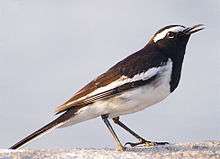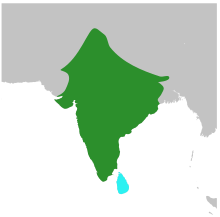White-browed wagtail
The white-browed wagtail or large pied wagtail (Motacilla maderaspatensis) is a medium-sized bird and is the largest member of the wagtail family. They are conspicuously patterned with black above and white below, a prominent white brow, shoulder stripe and outer tail feathers. White-browed wagtails are native to South Asia, common near small water bodies and have adapted to urban environments where they often nest on roof tops. The specific name is derived from the Indian city of Madras (now Chennai).
| White-browed wagtail | |
|---|---|
 | |
| Scientific classification | |
| Kingdom: | Animalia |
| Phylum: | Chordata |
| Class: | Aves |
| Order: | Passeriformes |
| Family: | Motacillidae |
| Genus: | Motacilla |
| Species: | M. maderaspatensis |
| Binomial name | |
| Motacilla maderaspatensis Gmelin, 1789 | |
 | |
| Year-round range (green), non-breeding visitor (blue) | |
| Synonyms | |
|
Motacilla madaraspatensis lapsus | |
Description
The white-browed wagtail is the largest species of wagtail at 21 cm (8.3 in) length. It is a slender bird, with the characteristic long, constantly wagging tail of its genus. It has black upperparts, head and breast, with a white supercilium and large white wingbar. Unlike white wagtails it never has white on the forehead. The rest of the underparts are white. The female has the black less intense than in the male. Juveniles are like the females brown-grey where the adult is black.[5][6][7]
Distribution and habitat
_carrying_feed_for_the_chicks_W_IMG_2622.jpg)
The white-browed wagtail is a resident breeder in India and is endemic to the Indian subcontinent. It is found south of the Himalayas, east of the Indus system and to the west of Bangladesh. It is rare in the higher altitude regions but has been seen in Ladakh on the edge of the Tibetan plateau.[8] In most of India it is found below 1000 m but in southern India it goes up into the hills up to 2200 m.[5] It is very rare in the Indus valley area.[9] It is absent from the Sind region of Pakistan. It is found in open freshwater wetland habitats. It is one of the few Motacilla wagtails that has adapted well to urban habitats and is often found perched on overhead water storages in residential buildings.[10][11]
It is a rare winter visitor to Sri Lanka and have possibly extended their range in recent times.[5][10][12]
Taxonomy and systematics
Stuart Baker in his second edition of The Fauna of British India considered this as a subspecies of the white wagtail, calling it Motacilla lugubris maderaspatensis.[5][13] This was however criticized by C B Ticehurst, who noted that it was much larger, never had the white forehead of the white wagtail, was non-migratory and lacked a spring moult.[14] This species is now considered to form a superspecies with Japanese wagtail, Mekong wagtail and the more distant African pied wagtail. Similarities in pre-copulatory behaviour with the Japanese wagtail have been noted.[15] Its song much resembles that of the recently described Mekong wagtail. mtDNA cytochrome b and NADH dehydrogenase subunit 2 sequence data has not been able to robustly resolve the relationships of these birds, especially in respect to the blue-headed wagtail and its relatives.[16]
The species is considered monotypic and subspecies such as kangrae described by Walter Koelz are not recognized.[17][18]
Behaviour and ecology
Usually seen in pairs or small groups near open water. They call often especially in the mornings[19] and are active like most other wagtails. They will perch on the ground as well as on wires or on buildings. The song is long and loud with many different notes. The usual call is a wheezy "wheech".[5] They can fly fairly rapidly for long distances and they fly with a bounding (dipping and rising) flight pattern and have been recorded to travel at the speed of about 40 km/h.[20]
Endoparasitic filarial parasites of the species Splendidofilaria singhi have been recorded in individuals of the species.[21]
Breeding
_collecting_waste_material_from_the_chicks_W_IMG_2647.jpg)
The breeding season is March to October.[5] In southern India, the nesting season begins when river levels drop and continue until the Monsoon rains.[10] In courtship, the male shoots into the air with a single wing beat, sings and glides with dangling legs and puffed feathers. On settling, the tail of the male is raised high and wings held up over the back and the tip is quivered stiffly while he steps around the female. The female responds by crouching and shivering the wings as if begging for food.[10][22]
It builds its cup-shaped nest placed on the ground or rocks in a hole, ledge or mud bank and is always located close to water. Artificial structures such as bridges and roof tops are also used.[23] Nests have been noticed in a regularly used ferry. The nest is made of grass, roots, algae and other material with a central neat cup lined with hair. Normally four, and three to five eggs is the usual clutch.[10][24]
Food
Like other wagtails, this species is insectivorous. Nestlings were mainly fed orthopterans, caterpillars and spiders.[25] Stayphylinid beetles and pentatomid bugs have also been recorded in their diet.[26] In captivity they have been recorded feeding on annelids.[27] They have adapted to urban environments where water may be found mainly on rooftops as overflow from storage tanks.[28]
In culture
In older times in India, the species was sometimes kept as a cage-bird and was acclaimed for its singing ability. The native name of khanjan is used in the phrase "khanjan-eyed" to describe someone with beautiful eyes.[29] The Khanjani was held sacred in India as it supposedly bore an impression of Vishnu's shaligram on its breast. [30] Another local name for wagtails in India is dhobin (or washerwoman).[31]
References
- BirdLife International. 2012. Motacilla madaraspatensis. In: IUCN 2012. IUCN Red List of Threatened Species. Version 2012.2. Downloaded on 3 June 2013.
- Jerdon, TC (1840). "Catalogue of the birds of the peninsula of India, arranged according to the modern system of classification; with brief notes on their habits and geographical distribution, and description of new, doubtful and imperfectly described specimens". Madras Jour. Lit. Sc. 11: 1–38.
- Blyth, Edward (1819). Catalogue of the birds in the Museum Asiatic Society. The Asiatic Society. p. 137.
- Stephens, JF (1817). General zoology. Volume 10. Part 2. Birds. Privately published, London. p. 548.
- Rasmussen, PC & JC Anderton (2005). Birds of South Asia: The Ripley Guide. Volume 2. Smithsonian Institution & Lynx Edicions. p. 315.
- Oates, EW (1890). The Fauna of British India, Including Ceylon and Burma. Birds. 2. Taylor and Francis, London. pp. 291–293.
- Whistler, Hugh (1949). Popular handbook of Indian birds (4 ed.). Gurney and Jackson, London. pp. 245–246. ISBN 1-4067-4576-6.
- Sangha, H. S. Naoroji, R. (2005). "Large Pied Wagtail Motacilla maderaspatensis Gmelin in Ladakh". J. Bombay Nat. Hist. Soc. 102 (3): 341.CS1 maint: multiple names: authors list (link)
- Whistler, H (1916). "Notes on the birds of the Jhelum District of the Punjab with notes on the collection by Claud Ticehurst". Ibis. 58: 35–118. doi:10.1111/j.1474-919X.1916.tb07842.x.
- Ali, S & S D Ripley (1998). Handbook of the birds of India and Pakistan. 9 (2 ed.). Oxford University Press. pp. 300–302. ISBN 0-19-562063-1.
- Khan, MMH (2005). "Species diversity, relative abundance and habitat use of the birds in the Sundarbans East Wildlife Sanctuary, Bangladesh" (PDF). Forktail. 21: 79–86.
- Hoffmann, Thilo W (1989). "Notes on the status and distribution of some birds in Sri Lanka as listed in S. D. Ripley (1982) "A Synopsis of the Birds of India and Pakistan together with those of Nepal, Bhutan, Bangladesh and Sri Lanka."". J. Bombay Nat. Hist. Soc. 86 (1): 7–16.
- Baker, ECS (1926). The Fauna of British India, Including Ceylon and Burma. Birds. 3 (2 ed.). Taylor & Francis, London. pp. 263–264.
- Ticehurst, CB (1922). "Notes on Indian wagtails". J. Bombay Nat. Hist. Soc. 28 (4): 1082–1090.
- Higuchi H & T Hirano (1989). "Breeding season, courtship behaviour, and territoriality of White and Japanese Wagtails Motacilla alba and M. randis" (PDF). Ibis. 131 (4): 578–588. doi:10.1111/j.1474-919X.1989.tb04793.x. hdl:2027.42/73846.
- Voelker, Gary (2002). "Systematics and historical biogeography of wagtails: Dispersal versus vicariance revisited". Condor. 104 (4): 725–739. doi:10.1650/0010-5422(2002)104[0725:SAHBOW]2.0.CO;2.
- Koelz, Walter (1939). "New birds from Asia, chiefly from India". Proc. Biol. Soc. Washington. 52: 61–82.
- Storer, RW (1988). Type specimens of birds in the collections of the University of Michigan Museum of Zoology. Miscellaneous Publications 174. University of Michigan Museum of Zoology. hdl:2027.42/56418.
- Newnham, A (1898). "The Large Pied Wagtail Motacilla maderaspatensis in captivity". J. Bombay Nat. Hist. Soc. 11 (3): 535–536.
- Acharya, H.N. (1933). "Speed of the Large Pied Wagtail Motacilla maderaspatensis (Gmelin)". J. Bombay Nat. Hist. Soc. 36 (4): 996–997.
- Sultana, A (1962). "New Species of Chandlerella Yorke and Maplestone, 1926, and Splendidofilaria Skrjabin, 1923, from Indian Birds, with a Discussion of Related Genera". Journal of Parasitology. 48 (5): 707–714. doi:10.2307/3275259. JSTOR 3275259.
- Kirkpatrick, KM (1954). "The courtship display of the Large Pied Wagtail Motacilla maderaspatensis (Gmelin)". J. Bombay Nat. Hist. Soc. 52 (3): 602–603.
- Biddulph, CH (1937). "Curious nesting sites of 'the Large Pied Wagtail [Motacilla lugubris maderaspatensis (Gmel.)]". J. Bombay Nat. Hist. Soc. 39 (2): 397–398.
- Hume, AO (1890). The nests and eggs of Indian birds. 2 (2 ed.). R H Porter, London. pp. 202–207.
- Verzhutskii, Boris (2002). "Diet of the Large Pied Wagtail Motacilla maderaspatensis in Auroville, Pondicherry". Zoos' Print Journal. 17 (9): 886. doi:10.11609/jott.zpj.17.9.886.
- D'Abreu, E A (1920). "Some insect prey of birds in the Central Provinces". Proceedings of the Third Entomological Meeting Held at Pusa on the 3rd to 15th February 1919. 3. Superintendent Government Printing, Calcutta. pp. 859–871.
- Mason, CW; edited by Maxwell-Lefroy, H (1912). "The food of birds in India". Memoirs of the Department of Agriculture in India, Entomological Series. 3: 1–371.CS1 maint: extra text: authors list (link)
- Bell, D.A. (1986). "An unusual nest site for the Large Pied Wagtail". Newsletter for Birdwatchers. 26 (7&8): 11–12.
- Law, Satya Churn (1923). Pet birds of Bengal. 1. Thacker, Spink & Co. pp. 240–264.
- "The Khunjunee". Chambers' Edinburgh Journal (441): 384. 1852.
- Finn, Frank (1906). Garden and aviary birds of India. Thacker and Spink. pp. 106–107.
Other sources
- Hussain, T., Ghafoor, A., Qureshi, J.I. (1989) Food habits of large pied wagtail (Motacilla maderaspatensis) . Pakistan Journal of Agricultural Sciences 26(4):426–431
- Patel, ST; Pilo, B; Shah, RV (1977) Oxidative metabolism in the liver and kidney of migratory Starling (Sturnus roseus) and Wagtail (Motacilla alba). Pavo 14(1&2):41–49.
- Chanda, S (1998): Courtship display of Large Pied Wagtail Motacilla maderaspatensis in Kokrajhar, Assam. Newsletter for Birdwatchers . 38(5):88.
External links
| Wikimedia Commons has media related to Motacilla maderaspatensis. |
